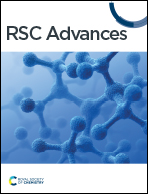A highly active Z-scheme SnS/Zn2SnO4 photocatalyst fabricated for methylene blue degradation†
Abstract
Herein, a highly active Z-scheme SnS/Zn2SnO4 photocatalyst is fabricated by a one-step hydrothermal route. The structure, composition, photoelectric and photocatalytic properties of the as-prepared photocatalysts are systematically researched. The results demonstrate that SZS-6 displays a good photocatalytic performance with an efficiency of 94.5% to degrade methylene blue (MB) under visible light irradiation (λ > 420 nm). And its degradation rate constant is up to 0.0331 min−1, which is 3.9 and 4.4 times faster than SnS and Zn2SnO4, respectively. The formation of a Z-scheme heterojunction facilitates the separation and transfer of charges, which improves the degradation of MB. The Z-scheme charge transfer pathway of the SnS/Zn2SnO4 photocatalyst is verified by the shifted peaks of the X-ray photoelectron spectroscopy (XPS) spectrum, the relative position of the bandgap, work function as well as free radical trapping experiments. The photocatalytic mechanism for the degradation of MB by SnS/Zn2SnO4 is proposed.



 Please wait while we load your content...
Please wait while we load your content...